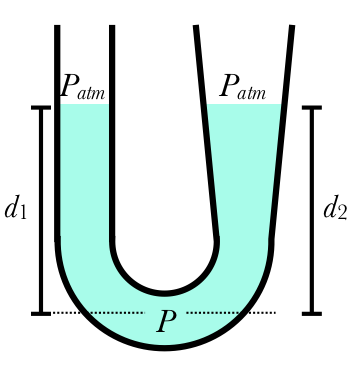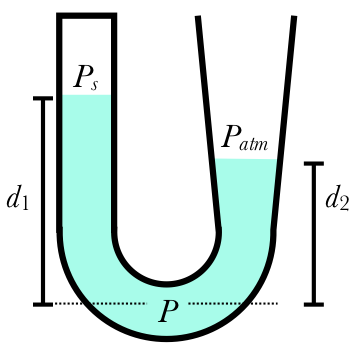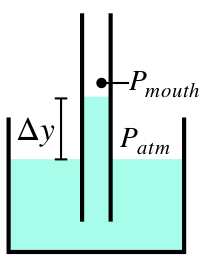Fluid Levels

Consider the U-shaped pipe shown on the right, filled with water, with both ends open to the atmosphere where the pressure is $P_{atm}$. Both surfaces of the water are connected at the bottom of the pipe, where the pressure is P. According to the left-hand side, $P = P_{\mathrm{atm}} + \rho_f gd_1$, while according to the right-hand side, $P = P_{\mathrm{atm}} + \rho_f gd_2$. For both of these to be true, $d_1 = d_2$:

in other words, the water level must be the same on both sides. This is a general result which is true whenever a fluid is in contact with the atmosphere at two or more places, even if the two sides are different widths or at crazy angles.

What must be true, however, is for both sides to be in contact with the same atmosphere. If one side is sealed off, then the air inside the sealed off portion may have a different pressure than the atmospheric pressure, and the levels do not have to be the same. In fact, we can use the difference in levels to determine the pressure $P_s$ inside the sealed-off section. In the case shown on the right, $$P=P_{\rm atm}+\rho_fgd_2=P_s+\rho_fgd_1$$ Solving this for $P_s$ gives us $$P_s=P_{\mathrm{atm}}+\rho_fg(d_2-d_1)$$ If $d_2 < d_1$, as it is here, then the second term is negative, and so the pressure in the sealed side is smaller than atmospheric pressure.

We can use this same analysis for studying how a straw (or a pump) works. The mouth creates a partial vacuum inside the straw, decreasing its pressure to $P_{\rm mouth}$; this causes the level of the fluid to rise inside the straw by a distance $\Delta y={P_{\rm atm}-P_s\over \rho_fg}$. The mouth keeps reducing the pressure inside the straw until the water level rise high enough to reach the mouth.